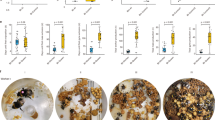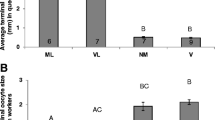Abstract
Worker sterility in the bumblebee Bombus terrestris is conditional and is linked to the social development of the colony. Workers refrain from reproducing or overtly challenging the queen until gyne production has initiated, at the so-called competition point (CP). It is not known whether this behavior is hard-wired or workers show reproductive plasticity. It also remains unclear whether worker reproductive decision is under queen and/or worker control. In this study, we tested worker reproductive plasticity in an attempt to assess whether and under which conditions worker sterility/fertility are reversible. We introduced egg-laying workers into colonies with different social structures for 1 week then monitored their reproductive status. We revealed a remarkable reproductive plasticity in the introduced workers that was social-condition-dependent. In the presence of a pre-CP queen, the introduced workers reverted to sterility, whereas in the presence of a post-CP queen, such workers remained egg-layer. Reversion to sterility does not occur when direct contact with the queen is prevented, as the introduced workers remained egg-layer in the queenright colonies with a confined queen. Egg-laying workers that were introduced into queenless colonies mostly maintained their fertility regardless of colony social phase. This shows that worker transition from cooperative to selfish behavior is reversible depending on the social context.




Similar content being viewed by others
References
Alaux C, Jaisson P, Hefetz A (2004a) Queen influence on worker reproduction in bumblebees (Bombus terrestris) colonies. Insect Soc 51:287–293
Alaux C, Savarit F, Jaisson P, Hefetz A (2004b) Does the queen win it all? Queen–worker conflict over male production in the bumblebee, Bombus terrestris. Naturwissenschaften 91:400–403
Alaux C, Jaisson P, Hefetz A (2005) Reproductive decision-making in semelparous colonies of the bumblebee Bombus terrestris. Behav Ecol Sociobiol 59:270–277
Alaux C, Hefetz A, Jaisson P (2006a) Plasticity of worker reproductive strategies in Bombus terrestris: lessons from artificial mixed-species colonies. Anim Behav 72:1417–1425
Alaux C, Jaisson P, Hefetz A (2006b) Regulation of worker reproduction in bumblebees (Bombus terrestris): workers eavesdrop on a queen signal. Behav Ecol Sociobiol 60:439–446
Bloch G (1999) Regulation of queen–worker conflict in bumblebee (Bombus terrestris) colonies. Proc R Soc Lond B 266:2465–2469
Bloch G, Borst DW, Huang ZY, Robinson GE, Hefetz A (1996) Effects of social conditions on juvenile hormone mediated reproductive development in Bombus terrestris workers. Physiol Entomol 21:257–267
Bloch G, Hefetz A (1999a) A reevaluation of the role of mandibular glands in regulation of reproduction of reproduction in bumblebee colonies. J Chem Ecol 25:881–896
Bloch G, Hefetz A (1999b) Regulation of reproduction by dominant workers in bumblebee (Bombus terrestris) queenright colonies. Behav Ecol Sociobiol 45:125–135
Bortolotti L, Duchateau MJ, Sbrenna G (2001) Effect of juvenile hormone on caste determination and colony processes in the bumblebee Bombus terrestris. Entomol Exp Appl 101:143–158
Bourke AFG, Ratnieks FLW (2001) Kin-selected conflict in the bumble-bee Bombus terrestris (Hymenoptera: Apidae). Proc R Soc Lond B 268:347–355
Cnaani J, Robinson GE, Bloch G, Hefetz A (2000) The effect of queen-worker conflict on caste determination in the bumblebee Bombus terrestris. Behav Ecol Sociobiol 47:346–352
Crespi BJ (1992) Cannibalism and trophic eggs in subsocial and eusocial insects. In: Elgar MA, Crespi BJ (eds) Cannibalism:ecology and evolution among diverse taxa. Oxford University Press, Oxford, pp 176–213
Dietemann V, Peeters C, Liebig J, Thivet V, Hölldobler B (2003) Cuticular hydrocarbons mediate discrimination of reproductives and nonreproductives in the ant Myrmecia gulosa. Proc Natl Acad Sci U S A 100:10341–10346
Duchateau MJ, Velthuis HHW (1988) Development and reproductive strategies in Bombus terrestris colonies. Behaviour 107:186–207
Duchateau MJ, Velthuis HHW (1989) Ovarian development and egg laying in workers of Bombus terrestris. Entomol Exp Appl 51:199–213
Duchateau MJ, Velthuis HHW, Boosma JJ (2004) Sex ratio variation in the bumblebee Bombus terrestris. Behavioral Ecology 15:71–82
Endler A, Liebig J, Schmitt T, Parker JE, Jones GR, Schreier P, Hölldobler B (2004) Surface hydrocarbons of queen eggs regulate worker reproduction in a social insect. Proc Natl Acad Sci U S A 101:2945–2950
Estoup A, Scholl A, Pouvreau A, Solignac M (1995) Monoandry and polyandry in bumble bees (Hymenoptera; Bombinae) as evidenced by highly variable microsatellites. Mol Ecol 4:89–93
Fletcher DJ, Ross KG (1985) Regulation of reproduction in eusocial Hymenoptera. Annu Rev Entomol 30:319–343
Foster KR, Ratnieks F (2001) Convergent evolution of worker policing by egg eating in the honeybee and common wasp. Proc R Soc Lond B 268:169–174
Foster KR, Ratnieks FLW (2000) Facultative worker policing in a wasp. Nature 407:692–693
Foster RL, Brunskill A, Verdirame D, O'Donnell S (2004) Reproductive physiology, dominance interactions, and division of labour among bumble bee workers. Physiol Entomol 29:327–334
Frank SA (1995) Mutual policing and repression of competition in the evolution of cooperative groups. Nature 377:520–522
Gobin B, Billen J, Peeters C (1999) Policing behaviour towards virgin egg layers in a polygynous ponerine ant. Anim Behav 58:1–6
Hammond RL, Keller L (2004) Conflict over male parentage in social insects. Plos Biol 2:1472–1482
Hartmann A, Wantia J, Torres JA, Heinze J (2003) Worker policing without genetic conflicts in a clonal ant. Proc Natl Acad Sci U S A 100:12836–12840
Heinze J, Stengl B, Sledge MF (2002) Worker rank, reproductive status and cuticular hydrocarbon signature in the ant, Pachycondyla cf. inversa. Behav Ecol Sociobiol 52:59–65
Hölldobler B, Bartz SH (1985) Sociobiology of reproduction in ants. In: Hölldobler B, Lindauer M (eds) Experimental behavioral ecology and sociobiology. Sinauer, Sunderland, pp 237–258
Keller L, Nonacs P (1993) The role of queen pheromones in social insects: queen control or queen signal. Anim Behav 45:787–794
Kikuta N, Tsuji K (1999) Queen and worker policing in the monogynous and monoandrous ant, Diacamma sp. Behav Ecol Sociobiol 46(3):180–189
Kukuk PF (1992) Oophagy as cannibalism in social bees. In: Elgar MA, Crespi BJ (eds) Cannibalism: ecological and evolutionary implications. Oxford University Press, Oxford, pp 214–237
Liebig J, Peeters C, Hölldobler B (1999) Worker policing limits the number of reproductive in a ponerine ant. Proc R Soc Lond B 266:1865–1870
Lopez-Vaamonde C, Koning JW, Brown RM, Jordan WC, Bourke AFG (2004) Social parasitism by male-producing reproductive workers in a eusocial insect. Nature 430:557–560
Monnin T, Peeters C (1997) Cannibalism of subordinates’ eggs in the monogynous queenless ant Dinoponera quadriceps. Naturwissenschaften 84:499–502
Oakes M (1990) Statistical inference. Epidemiology Resources, Chestnut Hill, MA
Ratnieks FLW (1988) Reproductive harmony via mutual policing by workers in eusocial Hymenoptera. Am Nat 132:217–236
Ratnieks FLW, Foster KR, Wenseleers T (2006) Conflict resolution in insect societies. Annu Rev Entomol 51:581–608
Ratnieks FLW, Visscher PK (1989) Worker policing in the honeybee. Nature 342:796–797
Röseler PF, Röseler I (1978) Studies on the regulation of juvenile hormone titre in bumble bee workers, Bombus terrestris. J Insect Physiol 24:707–713
Röseler PF, Röseler I, van Honk CGJ (1981) Evidence for inhibition of corpora allata activity in workers of Bombus terrestris by a pheromone from the queen's mandibular glands. Experentia 37:348–351
Schmid-Hempel R, Schmid-Hempel P (2000) Female mating frequencies in Bombus spp. from central Europe. Insect Soc 47:36–41
Seeley TD (1985) Honey bee ecology: a study of adaptation in social life. Princeton University Press, Princeton
Sledge MF, Trinca I, Massolo A, Boscaro F, Turillazzi S (2004) Variation in cuticular hydrocarbon signatures, hormonal correlates and establishment of reproductive dominance in a polistine wasp. J Insect Physiol 50:73–83
van Doorn A (1987) Investigations into the regulation of dominance behaviour and the division of labour in bumblebee colonies (Bombus terrestris). Neth J Zool 37:255–276
van Doorn A (1989) Factors influencing dominance behaviour in queenless bumblebee workers (Bombus terrestris). Physiol Entomol 28:66–70
van Doorn A, Heringa J (1986) The ontogeny of a dominance hierarchy in colonies of the bumblebee Bombus terrestris (Hymenoptera, Apidae). Insect Soc 33:3–25
van Honk VCGJ (1982) The social structure of Bombus terrestris colonies: a reveiw. In: Breed MD, Michener CD (eds) The biology of social insects. Westview Press, Boulder, Colorado, pp 196–199
van Honk VCGJ, Hogeweg P (1981) The ontogeny of the social structure in a captive Bombus terrestris colony. Behav Ecol Sociobiol 9:111–119
van Honk VCGJ, Röseler PF, Velthuis HHW, Hoogeven JC (1981) Factors influencing the egg laying of workers in a captive Bombus terrestris colony. Behav Ecol Sociobiol 9:9–14
van Honk VCGJ, Velthuis HHW, Rôseler PF, Malotaux ME (1980) The mandibular glands of Bombus terrestris queens as a source of queen pheromones. Ned Entomol Ver Amsterdam 28:191–198
Visscher PK (1989) A quantitative study of worker reproduction in honeybee colonies. Behav Ecol Sociobiol 25:247–254
Visscher PK (1996) Reproductive conflict in honey bees: a stalemate of worker egg-laying and policing. Behav Ecol Sociobiol 39:237–244
Visscher PK, Dukas R (1995) Honey bees recognize development of nestmates’ ovaries. Anim Behav 49:542–544
Wilson EO (1971) The insect societies. Harvard University Press, Cambridge, Massachusett
Woyciechowski M, Lomnicki A (1987) Multiple mating of queens and the sterility of workers among eusocial Hymenoptera. J Theor Biol 128:317–327
Acknowledgments
This work was funded by a J. and M.L. Dufrenoy grant (Académie d’Agriculture de France) to C.A. We thank Naomi Paz for editorial assistance, Eli Geffen for statistical advices and the Associate Editor Laurent Keller, Andrew Baube and one anonymous referee for helpful comments on the manuscript. The experiments comply with the current laws of France.
Author information
Authors and Affiliations
Corresponding author
Additional information
Communicated by L. Keller
Rights and permissions
About this article
Cite this article
Alaux, C., Boutot, M., Jaisson, P. et al. Reproductive plasticity in bumblebee workers (Bombus terrestris)—reversion from fertility to sterility under queen influence. Behav Ecol Sociobiol 62, 213–222 (2007). https://doi.org/10.1007/s00265-007-0455-6
Received:
Revised:
Accepted:
Published:
Issue Date:
DOI: https://doi.org/10.1007/s00265-007-0455-6




